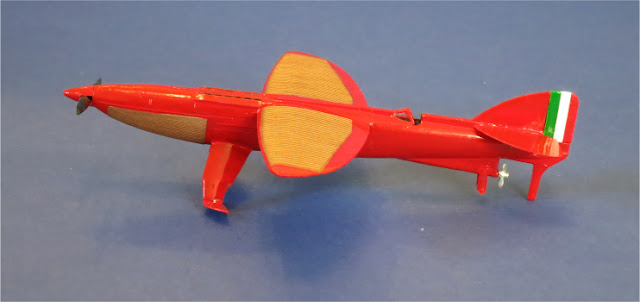This is the Piaggio-Pegna P.c.7 of 1929. It was one of a handful of designs built by the Italians for the Schneider Trophy that year, and much the most radical. Dare one say it, it's strikingly beautiful with lines reminiscent of a flying fish. Or, it resembles something that Thunderbirds (fondly remembered British kids' tv show) might have cooked up. And yes, I'm saying that despite calling the notorious SPAD S.A.2 'pulpit fighter' of WWI one of the worst planes ever flown, in a previous post, this was worse.So, what was the idea here? Short answer, it was an attempt to find an alternative to the need to carry large drag inducing floats. The Schneider Trophy was, after all, a contest for seaplanes, and although by 1929 they had become the fastest planes on the planet, they could be even faster without floats. Look back at the previous post about the ultimate winner, the Supermarine S.6B: the floats are as big as the plane itself. It wasn't merely that they had to support the plane in water: they had to be that big to counteract the enormous torque produced by a very powerful engine. The Piaggio-Pegna P.c.7 was intended to float low down on its sealed fuselage, until pushed forward by the water propeller (connected to the engine by a long shaft right under the pilot) and then up onto the water surface by the hydrofoils, when the airscrew could take over. In theory.
It didn't work. First they found the foils couldn't lift any further when they reached the surface layer; after redesign it still wasn't possible to lift the plane high enough to allow the airscrew to take over. And by then the reality of the situation had sunk in with the only pilot who'd volunteered to fly it. In the end, the Italian team - note, a group of men undoubtedly some of the world's best pilots - refused to continue with it. Would you? Taking off would have been dangerous enough. But I can't imagine surviving an attempt at landing it. If you need more; for one bad point, see how far back the cockpit is, and think about how little visibility the pilot would have had. Secondly, the shaft to the rear screw failed after an oil leak, and this was bad news because the designers hadn't provided access panels. And another: the contest was naturally held at very low level, and planes were often pitching in making turns. This plane looks a near certainty to do that the first turn it tried to make.
And yet it looks gorgeous, doesn't it, with those rakish foils, in that Italian Red and coppery brass acreage of radiators. Just wait till I get round to the M.C.72, then you'll see how serious the Italians got with the Schneider Trophy.I find it bizarre that there are actually TWO 1:72 models of this plane available. This one in plastic by AMP, and what is almost certainly a much better resin kit by SBS. I mean, it's practically a 'What-If' project. When you consider all the types of plane which have never been modelled, some very important, and obscure types like this get kitted - and all those Nazi jet paper projects which part of the market has such stupid lust for ("Luftwaffe '46") - it's a little frustrating. But, hey ho, I've been building up a small Schneider Trophy collection in 1:72, and this is part of the story.
It doesn't look as if AMP copied the SBS kit (unlikely simply because of the resin/plastic difference), and they did to be fair already have a growing series of Schneider kits, in 1:48 as well as 1:72. The detail in this one is reasonable. The instruction sheet is pretty, until you try to track down and identify some of the parts. But you'll get there in the end. At that point you'll also find a couple of unused parts, and yet be missing any sign that they ever included a water rudder. I scratched that, simple to do, but irritating, even at this kit's low price.
It does stand out, lined up next to some of the other racers. It's extraordinary and very cool. It was bound to fail and common sense should have put a stop to the project before anybody started cutting metal. But I'd curious to see how it performed today, fitted out with the sort of remote control technology we have. It might be possible to take off and even land. But I'm pretty sure it couldn't have managed the designer's claimed top speed of 800kmh!




Did any of the other seaplane designs udse retractable floats like this Blackburn I wonder? https://youtu.be/L-hTWm9h9qM
ReplyDeleteThere's one from WWI which leaped to mind, the German Ursinus WD.10 seaplane fighter. Google that, you'll see interesting pictures, and wonder why they didn't proceed with it. My guess is its mechanical complexity. As for the Blackburn B.20, did you see this article? https://www.dingeraviation.net/b20/blackburn_b20.htm Really interesting, it was promising but seems to have been shelved for accidental reasons/changed priorities.
Delete